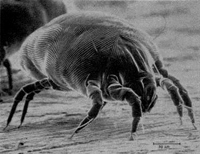Environmental Cardiopulmonary Disease Group
Our group is active in clinical and epidemiological research that investigates how the environment affects allergic and respiratory diseases such as asthma. This project has mainly focused on indoor allergen and bacterial lipopolysaccharide (LPS, endotoxin) exposures, which are important asthma risk factors. To achieve better understanding of the role of these exposures in asthma and other allergic diseases, we previously conducted the National Survey of Lead and Allergens in Housing (NSLAH) in collaboration with the Department of Housing and Urban Development (Vojta et al., Env Health Perspect 2002; Jacobs et al., Env Health Perspect 2002). To further these investigations, we developed and implemented an allergy/asthma-focused component for the National Health and Nutrition Examination Survey (NHANES) in collaboration with the National Institute of Allergy and Infectious Diseases and the Centers for Disease Control and Prevention/National Center for Health Statistics. This component, included in the NHANES 2005-2006 survey cycle, assessed allergy and asthma prevalence and morbidity, measured levels of common indoor allergens and endotoxin in bedroom reservoir dust, and quantified total and 19 allergen-specific IgEs (sIgE) in serum of participants (Hoppin et al., Am J Epidemiol 2011; Salo et al., J Allergy Clin Immunol 2014; Salo et al., J Allergy Clin Immunol 2018). In addition to large observational studies, we have also conducted environmental interventions to reduce indoor allergen levels in homes.
Prevalence and characteristics of indoor allergen and endotoxin exposures
The NSLAH was the first population-based study to investigate how levels of indoor allergens and endotoxin vary in U.S. households (Vojta et al., Env Health Perspect 2002). The NHANES 2005-2006 assessed indoor allergen and endotoxin levels in bedroom dust collected from nearly 7000 homes, providing the largest nationally representative data resource to date (Salo et al., J Allergy Clin Immunol 2018). Both surveys demonstrated that allergens are found in almost all homes (>99%), with cat and dog allergens being the most frequently detected allergens (Salo et al. J Allergy Clin Immunol 2008; Salo et al., J Allergy Clin Immunol 2018). Exposure to multiple allergens was common. More than 90% of NHANES participants had three or more detectable allergens in their homes, and 73% had at least one allergen at elevated levels. Allergen levels were influenced by sociodemographic, regional, climatic and housing factors, but each allergen appeared to have a distinct set of predictors (Arbes et al., J Allergy Clin Immunol 2003; Arbes et al., J Allergy Clin Immunol 2004; Cohn et al., J Allergy Clin Immunol 2004; Salo et al., J Allergy Clin Immunol 2005; Cohn et al., Env Health Perspect 2006; Salo et al., J Allergy Clin Immunol 2018). Allergen and endotoxin levels in the home also varied by room and location. Both surveys showed that lower family income, as well as presence of children, pets, cockroaches, and smokers in the home were consistently associated with higher endotoxin levels, although predictors of elevated endotoxin levels showed variation across climate regions (Thorne et al., Environ Health Perspect 2009; Thorne et al., Am J Respir Crit Care Med 2015; Mendy et al., Environ Int 2018). Presence of pets and pests had a major influence on household allergen burden. Housing characteristics also mattered in that elevated exposure to multiple allergens was more likely in mobile homes, older homes, rental homes, and homes in rural areas.
Allergic disease and exposure to indoor allergens and endotoxin
The NSLAH findings highlighted the importance of indoor allergen exposures in asthma exacerbations (Salo et al. J Allergy Clin Immunol 2008). However, the relationship between allergen exposure and asthma is complex and varies by allergen type (Salo et al., Curr Allergy Asthma Rep 2018). For example, exposure to elevated mouse allergen levels significantly increased the likelihood of asthma symptoms only in allergic individuals (Salo et al., Environ Health Perspect 2009), whereas elevated Alternaria levels in the home increased the likelihood of having asthma symptoms in all NSLAH participants (Salo et al., J Allergy Clin Immunol 2006). Exposure to cat and dog allergens, which was widespread and common in U.S. homes, was associated with increased asthma morbidity in pet-sensitive individuals. Our NHANES findings suggested that 44% of asthma attacks were attributable to exposure to high levels of dog allergen among dog-sensitive asthmatics and 30% were attributable to elevated cat allergen exposure among cat-sensitive asthmatics (Gergen et al., J Allergy Clin Immunol Pract 2018). Although allergic sensitization in adults tended to decrease with increasing age, sensitization to indoor allergens remained an important asthma risk factor in the elderly (Busse et al., Ann Allergy Asthma Immunol 2013). Our studies suggested that asthma-related symptoms were also influenced by endotoxin levels and total dust exposure in the home (Thorne et al., Am J Respir Crit Care Med 2005; Elliott et al., Environ Health Perspect 2007; Thorne et al., Am J Respir Crit Care Med 2015; Mendy et al., J Allergy Clin Immunol Pract 2018; Mendy et al., Environ Health 2020).
While most asthma in the U.S. was allergic in nature (Arbes et al., J Allergy Clin Immunol 2007), our work showed that a significant portion of asthma was independent of IgE levels, either total or specific (Gergen et al., J Allergy Clin Immunol 2009). The data from NHANES 2005-2006 demonstrated that total IgE predicted asthma only in allergic individuals, but not among non-allergic subjects.
Our studies have provided quantitative and qualitative information on sensitization patterns in the general U.S. population and highlighted the importance of different allergens in commonly reported allergic conditions, including hay fever (Arbes et al., J Allergy Clin Immunol 2005; Arbes et al., J Allergy Clin Immunol 2007; Salo et al., J Allergy Clin Immunol 2011; Salo et al., J Allergy Clin Immunol 2014). Although food allergy is a growing public health concern, the prevalence and patterns of food allergy are not well characterized at the national level. In collaboration with experts in the field of food allergy, our group examined the prevalence and demographic determinants of food allergy, identified high-risk populations, and explored associations with other immune-mediated conditions, including asthma (Liu et al., J Allergy Clin Immunol 2010). Nationally representative data from NHANES also enabled us to investigate changes in food sensitization over time in U.S. children (McGowan et al., J Allergy Clin Immunol Pract 2016; McGowan et al., Ann Allergy Asthma Immunol 2016; McGowan et al., Ann Allergy Asthma Immunol 2019).
Modifying factors for allergic disease
Our group has also expanded understanding of factors that may modify the prevalence and exacerbation of allergic and respiratory diseases. Our collaborative work showed that obesity was associated with asthma and allergic status in children (Visness et al., J Allergy Clin Immunol 2009; Visness et al., J Asthma 2010). More recently, we have examined the role of climatic factors as well as air pollution, phthalate, bisphenol, and antioxidant exposures in allergic and respiratory outcomes (Hoppin et al., Environ Health Perspect 2013; Weir et al., Respir Med 2013; Mendy et al., Environ Int 2018; Mendy et al., Am J Respir Crit Care Med 2019; Mendy et al., Environ Res 2020; Salo et al., Respir Res 2022).
Because systemic inflammation might contribute to the development of allergic disease, our group has investigated its role in asthma pathogenesis in more detail. Little is known about relationships between cholesterol and inflammatory lung disease, although there is emerging evidence that cholesterol metabolism and inflammation are linked in the lung. In collaboration with Michael Fessler, M.D., our group found novel, inter-racial differences in the relationship between serum cholesterol and allergic disease (Fessler et al., J Allergy Clin Immunol 2009; Fessler et al., Allergy 2010). Our subsequent studies showed associations between atopy and myocardial infarction and characterized the relationship between serum cholesterol and circulating erythrocyte/platelet indices in U.S. adults (Jaramillo et al., J Allergy Clin Immunol 2013; Fessler et al., J Lipid Res 2013). Our more recent findings also suggested that residential endotoxin exposure may influence peripheral white blood cell counts and systemic inflammatory state (Fessler et al., Environ Health Perspect 2017).
Environmental interventions and allergen mitigation
Our group has conducted studies to test the feasibility and effectiveness of various interventions to reduce indoor allergen levels in homes. Since sensitization to dust mite and cockroach allergens is an important asthma risk factor, our group focused initial efforts on the development of effective dust mite and cockroach allergen mitigation strategies (Vojta et al., Env Health Perspect 2001). While asthmatics and others with dust mite allergies are encouraged to implement strategies to avoid dust mite exposure, they often lack objective evidence that their efforts are successful in reducing dust mite allergen levels. Commercial in-home test kits have introduced the capability to monitor the effectiveness of allergen reduction strategies by providing an affordable, simple way to measure dust mite allergen levels on a regular basis. Our interventional study showed that the use of test kits along with education may beneficially influence behaviors and attitudes toward dust mite reduction strategies and help reduce residential dust mite allergen levels (Winn et al., J Asthma 2016).
Our group’s collaborative work with Coby Schal, Ph.D. (North Carolina State University) has resulted in significant reductions in residential cockroach allergen levels through the use of a novel, efficient eradication method (Arbes et al., J Allergy Clin Immunol 2003; Arbes et al., J Allergy Clin Immunol 2004).This method, which utilized intensive cockroach extermination, was validated in a year-long study that compared the new method with extermination services provided by commercial pest control companies. Our new eradication method proved to be much more effective than pest control services offered by commercial companies. While the homes serviced by commercial pest control companies also experienced reductions in the number of cockroaches in the homes, the magnitude of the reduction was significantly lower than in the homes that received the novel treatment. The cockroach infestation remained relatively high after 12 months, and changes in cockroach allergens in homes serviced by commercial pest control companies were not different from those in untreated control homes (Sever et al., J Allergy Clin Immunol 2007). Although additional research is warranted to test the efficacy of this method in reducing asthma morbidity, another study that used our cost-effective strategy for cockroach abatement has reported improved asthma outcomes in children (Rabito et al., J Allergy Clin Immunol 2017).
Asthma guidelines
In collaboration with several federal agencies including the Centers for Disease Control and Prevention and national asthma experts, we developed and implemented a supplemental questionnaire for the National Ambulatory Medical Care Survey (NAMCS) that evaluates the utilization and provision of ambulatory care services in the U.S. Our survey component, included in NAMCS 2012, was the first to collect nationally representative data on clinicians’ opinions, self-efficacy, and clinical decisions regarding asthma care and key components of the national asthma guidelines. Findings from this study demonstrated notable differences in guideline agreement, adherence, and implementation among asthma care providers. Agreement and adherence to the asthma guidelines were higher for specialists than primary care clinicians, but were low for both groups for several key recommendations (Cloutier et al., J Allergy Clin Immunol Pract 2018). To further elucidate factors underlying guideline uptake, we examined variation in guideline implementation among different primary care specialties as well as asthma specialists (Akinbami et al., J Asthma 2020; Cloutier et al., J Allergy Clin Immunol Pract 2020; Salo et al., J Allergy Clin Immunol Glob 2024). Our findings highlighted areas where guideline uptake was suboptimal and identified areas and approaches for future research and implementation strategies.
Summary
Our group’s research has:
- Provided nationally representative estimates on indoor allergen and endotoxin exposures in the U.S. population
- Improved understanding of the characteristics and predictors of indoor allergen and endotoxin exposures
- Characterized quantitative and qualitative IgE-mediated sensitization patterns in the U.S. population
- Led to better understanding of the national prevalence patterns of food allergy
- Highlighted the importance of indoor allergens and endotoxin exposures in allergy and asthma morbidity
- Increased knowledge on potentially modifiable risk factors for allergic and respiratory diseases such as asthma
- Led to novel methodologies that are used in epidemiological and interventional studies
- Improved understanding of factors and clinical decision-making underlying variations in adherence to asthma guidelines at the national level







